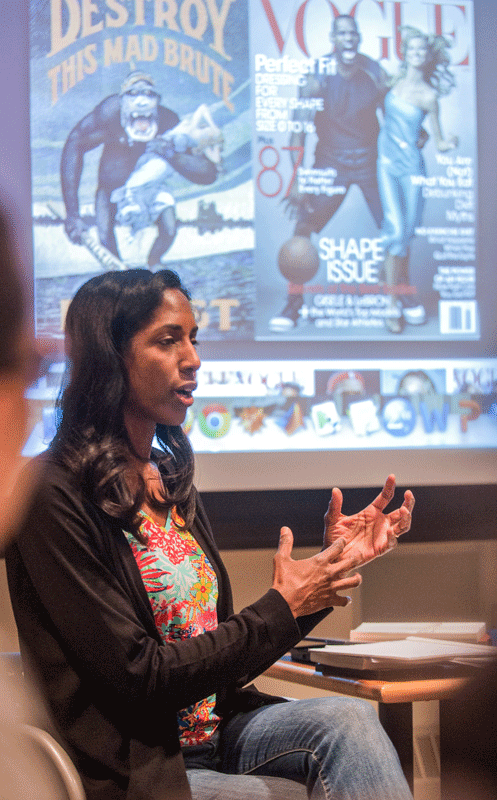African Americans through the Lens
Professor Mia Mask’s African American Cinema students consider how African Americans have been portrayed on the screen over the last 100 years, and how those portrayals impact cultural attitudes.

Associate Professor of Film Mia Mask says she believes one of the best ways to analyze American culture is through the lens of a movie camera. In her course African American Cinema, Mask helps her students examine how African Americans have been portrayed on the screen over the last 100 years and how those portrayals have mirrored cultural attitudes toward minorities.
“I’m constantly reminding my students that when we view these films, we have to put them into historical context,” Mask says. “We have to ask ourselves, ‘Why was this particular film made at this particular time?’”
Mask has immersed herself in scholarship that examines that intriguing question. She is the author of Divas on Screen: Black Women in American Film, published by the University of Illinois Press, and editor of the anthology Contemporary Black American Cinema: Race, Gender and Sexuality at the Movies. Her scholarly essays are published in the African American National Biography, Screen Stars of the 1990s, Film and Literature, and American Cinema of the 1970s.
In order to answer her question about why a particular film emerges at a particular time, students are required to go to the source. They view one full-length feature film per week, starting with Paul Robeson’s The Emperor Jones, and view such seminal works as A Raisin in the Sun, director Michael Roemer’s award-winning Nothing But a Man, and the blaxploitation classic Shaft. They also view two films by acclaimed African American director Charles Burnett, Killer of Sheep and To Sleep with Anger; Robert Townsend’s satiric Hollywood Shuffle; and the 2014 Academy Award winner 12 Years a Slave. Mask shows clips of numerous other films in class, and her assigned readings include not only film criticism but also commentary on American culture by such writers as James Baldwin, Donald Bogle, and bell hooks.
Mask says she enjoys teaching African American Cinema in part because the subject matter is constantly evolving. “I add new films every time I teach the course, but I tend to shy away from brand-new films and wait a couple of years to show them in class. I probably won’t include Selma the next time I teach the course, but it’s definitely one I’ll teach down the road.”
During one class, Mask asks her students to discuss their reaction to the largely stereotypical characters in Shaft. In the opening credits, the camera follows the title character, John Shaft, played by Richard Roundtree, as he strides through a gritty and grimy Times Square, defying traffic lights and establishing himself as a man who doesn’t mind breaking the rules.
In the film, Shaft, a private detective, is hired to rescue the daughter of a black mobster who has been kidnapped by the Italian Mafia. He accomplishes his mission after defying police and burning down part of a building.
After viewing the film, Renee Bryant ’16, a political science and Africana Studies double major, says she felt ambivalent about the portrayal of Shaft as a black superhero. The character represents the emergence of the black power movement in the 1960s and ’70s, Bryant says, “and I can take pride in Shaft’s ability to rise above all obstacles and save the damsel in distress. But in real life, he never would have gotten away with the way he did it, so the portrayal isn’t exactly accurate.”
She says the course has helped her gain an enhanced perspective on the role of film in defining, “both accurately and inaccurately, the black experience in American history.”
Film major Anna Iovine ’16 says, “African American cinema was something I didn’t know much about, and this course has shown me how pervasive stereotyping has been in films for a hundred years.” She particularly enjoyed A Raisin in the Sun “because it breaks some of those stereotypes—it’s essentially a story about a family that comes together to overcome barriers.”
